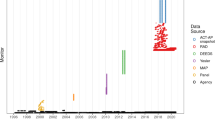Abstract
In this paper we discuss a pilot study where we have mapped urban air pollution using mobile carbon monoxide (CO) sensors. Our objective is to use inexpensive Global Positioning System (GPS) receivers to track the sensors and explore CO variations at a fine geographic scale. The critical issue in data processing is the treatment of the imprecise logs from the GPS. By using knowledge about the route and the geometry of the buildings, we are able to increase the position accuracy significantly, while at the same time showing that certain events, such as CO profiles while crossing roads, can be detected with a high degree of accuracy. Comparisons between data from our own mobile sensors and a fixed sensor site show good agreement in the vicinity of the fixed sensor, while at the same time identifying significant CO peaks within 100 m of this location. Using the mobile sensors to collect data along two of the main roads in the area, we are able to show CO variations along an urban canyon for parallel and perpendicular wind directions. Finally, a number of significant sources of CO were discovered during the course of the study, which suggest possible locations for fixed sensor sites in the future. We conclude by discussing the results in the context of the push towards large sensor networks and mobile communications. The potential for ad hoc mobile sensor networks may be very large.
Similar content being viewed by others
References
Boddy, J. W. D., Smalley, R. J., Dixon, N. S., Tate, J. E., & Tomlin, A. S. (2005). The spatial variability in concentrations of a traffic-related pollutant in two street canyons in York, UK – Part I: The influence of background winds. Atmospheric Environment, 39(17), 3147–3161.
COST Technical Committee on the Environment (2004). 9th international conference on harmonization within atmospheric dispersion modelling for regulatory purposes. COST Action 715.
Croxford, B., Penn, A., & Hillier, B. (1995). Spatial distribution of urban pollution: Civilizing urban traffic. 5th symposium on highway and urban pollution. Copenhagen, Denmark. Science of The Total Environment, 189–190, 3–9 (28 October 1996).
DAPPLE (Dispersion of Air Pollutants and their Penetration into the Local Environment) (2005). URL: http://www.dapple.org.uk/.
GARMIN (2004). GARMIN fourth quarter financial report for 2004. Available online: http://www.garmin.com/aboutGarmin/invRelations/releases/Q42004EarningsPressRelease.pdf.
Ghanem, M. Guo, Y., Hassard, J., Osmond, M., & Richards M. (2004). Discovery net sensor grid for air pollution monitoring. In Proceedings of the 3rd UK e-Science All-hands Conference AHM 2004 (pp. 106–113). Nottingham UK. ISBN 1-904425-21-6. Available online: http://www.discovery-on-the.net/papers_documentation.html#published.
Manning, A. J., Nicholson, K. J., Middleton, D. R., & Rafferty, S. C. (1998). Field study of wind and traffic to test a street canyon pollution model. Environmental Monitoring and Assessment, 60(3), 283–313.
Milton, R., & Steed, A. (2005). Correcting GPS Readings from a Tracked Mobile Sensor, In T. Strang & C. Linnhoff-Popien (Eds.), Location- and context-awareness: First international workshop, LoCA 2005, Springer-Verlag GmbH, May 12–15, 2005, Oberpfaffenhofen (near Munich), Germany, Lecture Notes in Computer Science Volume 3479/2005, pp. 83–94. Springer-Verlag GmbH. Available online: http://loca2005.context-aware.org/.
Ochieng, W. Y., Polak, J., Noland, R., Park, J.-Y., Zhao, L., Briggs, D., et al. (2003). Integration of GPS and dead reckoning for real-time vehicle performance and emissions monitoring. GPS Solutions, 6(4), 229–241, March (Springer-Verlag GmbH).
Weijers, E. P., Khlystov, A. Y., Kos, G. P. A., & Erisman, J. W. (2004). Variability of particulate matter concentrations along roads and motorways determined by a moving measurement unit. Atmospheric Environment, 39(19), 2993–3002.
Author information
Authors and Affiliations
Corresponding author
Rights and permissions
About this article
Cite this article
Milton, R., Steed, A. Mapping Carbon Monoxide Using GPS Tracked Sensors. Environ Monit Assess 124, 1–19 (2007). https://doi.org/10.1007/s10661-006-9488-y
Published:
Issue Date:
DOI: https://doi.org/10.1007/s10661-006-9488-y




